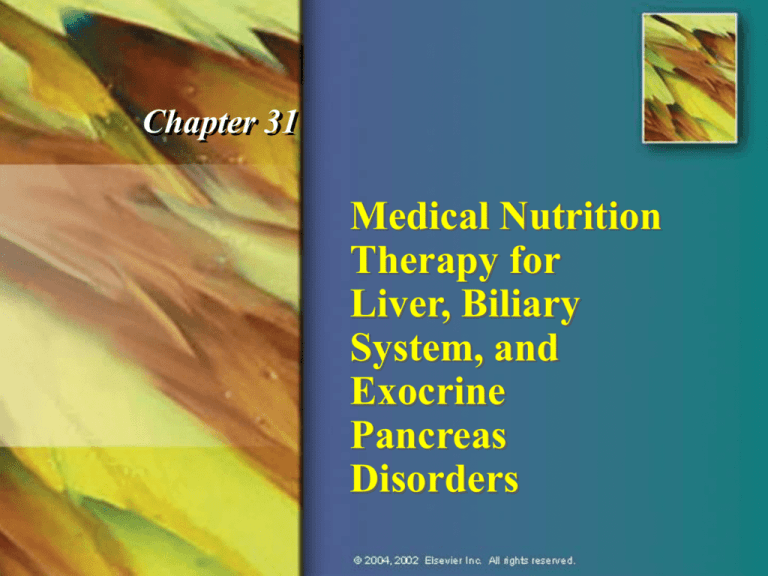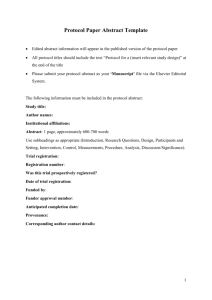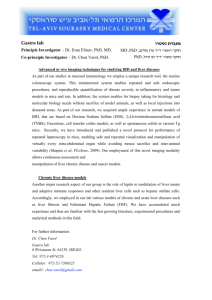
Chapter 31
Medical Nutrition
Therapy for
Liver, Biliary
System, and
Exocrine
Pancreas
Disorders
Most Common Liver Disease
Alcohol excess and abuse
Fourth leading cause of death among
middle-aged Americans
Alcohol problems are highest among
young adults, ages 18 to 29.
© 2004, 2002 Elsevier Inc. All rights reserved.
Common Laboratory Tests Used to
Test for Liver Function
Hepatic excretion
—Total serum bilirubin, urine bilirubin
Cholestasis tests
—Serum alkaline phosphatase
Hepatic enzymes
—ALT, AST
© 2004, 2002 Elsevier Inc. All rights reserved.
Common Laboratory Tests Used to
Test for Liver Function—cont’d
Serum proteins
—PT, PTT, serum albumin
Markers of specific liver diseases
—Serum ferritin, ceruloplasmin
Specific tests for viral hepatitis
—IgM anti-HAV, anti-HBS, HCV-RNA
© 2004, 2002 Elsevier Inc. All rights reserved.
Diseases of the Liver
Acute viral hepatitis
Fulminant hepatitis
Chronic hepatitis
Alcoholic liver disease, alcoholic
hepatitis, and cirrhosis
© 2004, 2002 Elsevier Inc. All rights reserved.
Diseases of the Liver—cont’d
Cholestatic liver diseases
—Primary biliary cirrhosis
—Sclerosing cholangitis
Inherited disorders
Other liver diseases
© 2004, 2002 Elsevier Inc. All rights reserved.
Acute Viral Hepatitis
Widespread inflammation of the liver that
is caused by hepatitis viruses A, B, C, D,
and E
Four phases of symptoms:
1. Prodromal phase
2. Preicteric phase
3. Icteric phase
4. Convalescent phase
© 2004, 2002 Elsevier Inc. All rights reserved.
Fulminant Hepatitis
Syndrome in which severe liver
dysfunction is accompanied by hepatic
encephalopathy
© 2004, 2002 Elsevier Inc. All rights reserved.
Chronic Hepatitis
At least 6-month course of hepatitis or
biochemical and clinical evidence of liver
disease with confirmatory biopsy findings
of unresolving hepatic inflammation
© 2004, 2002 Elsevier Inc. All rights reserved.
Alcoholic Liver Disease
Disease resulting from excessive alcohol
ingestion characterized by fatty liver
(hepatic steatosis), hepatitis, or cirrhosis
© 2004, 2002 Elsevier Inc. All rights reserved.
Alcoholic Liver Disease
Metabolic Changes
Steatorrhea
Wernicke-Korsakoff syndrome
Peripheral neuropathy
Pellagrous psychosis
Folate deficiency
© 2004, 2002 Elsevier Inc. All rights reserved.
End-Stage Alcoholic Liver Disease
Possible Characteristics
Malnutrition
Portal hypertension with varices
Ascites
Hyponatremia
Hepatic encephalopathy
Glucose alterations
© 2004, 2002 Elsevier Inc. All rights reserved.
End-Stage Alcoholic Liver Disease
Possible Characteristics—cont’d
Fat malabsorption
Osteopenia
Thrombocytopenia with anemia
© 2004, 2002 Elsevier Inc. All rights reserved.
Cholestatic Liver Diseases
Primary biliary cirrhosis (PBC)
—An immune-mediated chronic cirrhosis of
the liver due to obstruction or infection
of the small and intermediate-sized
intrahepatic bile ducts, whereas the
extrahepatic biliary tree and larger
intrahepatic ducts are normal
—90% of patients are women
© 2004, 2002 Elsevier Inc. All rights reserved.
Cholestatic Liver Diseases—cont’d
Sclerosing cholangitis
—Fibrosing inflammation of segments of
extrahepatic bile ducts, with or without
involvement of intrahepatic ducts
© 2004, 2002 Elsevier Inc. All rights reserved.
Inherited Disorders
Hemochromatosis
—Inherited disease of iron overload
Wilson’s disease
—Autosomal recessive disorder
associated with impaired biliary copper
excretion
α1-antitrypsin deficiency
—Causes cholestasis or cirrhosis and can cause
liver and lung cancer
© 2004, 2002 Elsevier Inc. All rights reserved.
Other Liver Diseases
Several other causes of liver disease,
including
—Liver tumors
—Systemic diseases (rheumatoid
arthritis, systemic sclerosis)
—Nonalcoholic steatohepatitis
—Acute ischemic and chronic
congestive hepatopathy
—Parasitic, bacterial, fungal, and
granulomatous liver diseases
© 2004, 2002 Elsevier Inc. All rights reserved.
Normal Liver vs. Damaged Liver
© 2004, 2002 Elsevier Inc. All rights reserved.
Complications of Excessive Alcohol Consumption Stem
Largely from Excess Hydrogen and from Acetaldehyde
© 2004, 2002 Elsevier Inc. All rights reserved.
Microscopic Appearance of (A) a Normal Liver
and (B) Acute Fatty Liver
(Adapted from Bray GA. Gray DS, Obesity, part 1: Pathogenisis. West J Med 149:429, 1988; and Lew EA, Garfinkle L; Variations
in mortality
(From Kanel
by weight
G, Korula
among
J. Atlas
750,000
of Liver
menPathology.
and women.
W.B.
J Clin
Saunders,
Epidemiol
1992.)
32:563, 1979.)
© 2004, 2002 Elsevier Inc. All rights reserved.
Clinical Manifestations of Cirrhosis
© 2004, 2002 Elsevier Inc. All rights reserved.
Factors That Affect Interpretation of Objective
Nutrition Assessment Tests in Patients with
End-Stage Renal Disease
Body weight
Anthropometric
measurements
3-methylhistidine
excretion
Creatinine-height
index
Visceral protein
levels
Immune function
tests
Nitrogen balance
studies
© 2004, 2002 Elsevier Inc. All rights reserved.
SGA Parameters for Nutritional
Evaluation of Liver Transplant
Candidates
History
Physical
Existing conditions
Nutritional rating (based on results of
above parameters)
© 2004, 2002 Elsevier Inc. All rights reserved.
Severe Malnutrition and Ascites in a Man with
End-Stage Renal Disease
© 2004, 2002 Elsevier Inc. All rights reserved.
Malnutrition in Liver Disease—Cause
Algorithm content developed by John Anderson, PhD, and Sanford C. Garner, PhD, 2000. Updated by Jeanette M. Hasse and
Laura E. Matarese, 2002.
© 2004, 2002 Elsevier Inc. All rights reserved.
Malnutrition in Liver Disease—
Pathophysiology
Algorithm content developed by John Anderson, PhD, and Sanford C. Garner, PhD, 2000. Updated by Jeanette M. Hasse and
Laura E. Matarese, 2002.
© 2004, 2002 Elsevier Inc. All rights reserved.
Malnutrition in Liver Disease—Medical and
Nutritional Management
Algorithm content developed by John Anderson, PhD, and Sanford C. Garner, PhD, 2000. Updated by Jeanette M. Hasse and
Laura E. Matarese, 2002.
© 2004, 2002 Elsevier Inc. All rights reserved.
Vitamin/Mineral Deficits in Severe
Hepatic Failure
Vitamin A
Niacin
Vitamin D
Thiamin
Vitamin E
Zinc
Vitamin K
Magnesium
Vitamin B6
Iron
Vitamin B12
Potassium
Folate
Phosphorus
© 2004, 2002 Elsevier Inc. All rights reserved.
Four Stages of Hepatic
Encephalopathy
Stage
Symptom
I
Mild confusion, agitation,
irritability, sleep disturbance,
decreased attention
II
Lethargy, disorientation,
inappropriate behavior, drowsiness
III
Somnolence but arousable,
incomprehensible speech, confusion,
aggression when awake
IV
Coma
© 2004, 2002 Elsevier Inc. All rights reserved.
End-Stage Liver Disease
Hepatic Encephalopathy
1. Consider major causes of encephalopathy
• GI bleeding
• Fluid and electrolyte abnormalities
• Uremia
• Use of sedatives
• Hypo- or hyperglycemia
• Alcohol withdrawal
• Constipation
• Acidosis
© 2004, 2002 Elsevier Inc. All rights reserved.
End-Stage Liver Disease
Hepatic Encephalopathy—cont’d
2. Treat underlying cause.
3. Treat with medications.
• Lactulose
• Neomycin
4. Ensure adequate diet is consumed.
© 2004, 2002 Elsevier Inc. All rights reserved.
End-Stage Liver Disease
Energy: 30 to 35 kcal/kg dry weight
BEE x 1.2 to 1.5, depending on degree of
malnutrition
Fat: 25% to 40% of kcal
May try MCT if steatorrhea is present; with
severe case, try fat restriction and discontinue if
diarrhea does not improve
Protein: 1to 1.5 g/kg dry wt depending on
degree of malnutrition, malabsorption, metabolic
stress
© 2004, 2002 Elsevier Inc. All rights reserved.
End-Stage Liver Disease—cont’d
May try BCAA formulas for >grade 2
encephalopathy
CHO: high intake of both complex and
simple carbohydrates
Vitamin and mineral supplements
Electrolytes: restrict sodium with edema or
ascites (2-4 g/day)
Fluid: restrict fluid if hyponatremia is
present
© 2004, 2002 Elsevier Inc. All rights reserved.
Amino Acids Commonly Altered
in Liver Disease
Aromatic amino acids—serum levels increased
—Tyrosine
—Phenylalanine*
—Free tryptophan*
Branched-chain amino acids—serum levels decreased
—Valine*
—Leucine*
—Isoleucine*
Other amino acids—serum levels increased
—Methionine*
—Asparagine
—Glutamine
—Histidine*
* Denotes essentials amino acids
© 2004, 2002 Elsevier Inc. All rights reserved.
Medications Commonly Used after
Liver Transplantation
Azathioprine
Muromonab-CD3
Antithymocyte
globulin
Mycophenolate
mofetil
Basiliximab
Sirolimus
Cyclosporine
Tacrolimus
Daclizumab
15-deoxysperagualin
Glucocorticoids
© 2004, 2002 Elsevier Inc. All rights reserved.
Nutrition Care Guidelines for Liver
Transplantation
Pretransplantation
Calories
Immediate
posttransplantation
Protein
Fat
Carbohydrate
Sodium
Fluid
Calcium
Vitamins
Long-term
posttransplantation
© 2004, 2002 Elsevier Inc. All rights reserved.
Liver Transplantation—Diet
Nutrition support: pre- and posttransplant
Long-term preventive nutrition to optimize
health and to avoid or minimize
—Excessive weight gain
—Hyperlipidemia
—Hyperglycemia
—Hypertension
—Osteopenia
© 2004, 2002 Elsevier Inc. All rights reserved.
Relationship of Organs of the Upper Abdomen
A, Liver (retracted upward); B, gallbladder; C, esophageal opening of the stomach; D, stomach (shown in dotted outline); E, common
bile duct; F, duodenum; G, pancreas and pancreatic duct; H, spleen; I, kidneys.
Courtesy The Cleveland Clinic Foundation, Cleveland, Ohio, 2002.
© 2004, 2002 Elsevier Inc. All rights reserved.
Some Tests of Pancreatic Function
© 2004, 2002 Elsevier Inc. All rights reserved.
Pancreatic Disorders—Cause
Algorithm content developed by John Anderson, PhD, and Sanford C. Garner, PhD, 2000.
© 2004, 2002 Elsevier Inc. All rights reserved.
Pancreatic Disorders—Pathophysiology
Algorithm content developed by John Anderson, PhD, and Sanford C. Garner, PhD, 2000.
© 2004, 2002 Elsevier Inc. All rights reserved.
Pancreatic Disorders—Medical and Nutritional
Management
Algorithm content developed by John Anderson, PhD, and Sanford C. Garner, PhD, 2000. Updated by Jeanette M. Hasse and
Laura E. Matarese, 2002.
© 2004, 2002 Elsevier Inc. All rights reserved.
Clinical Manifestations of Cirrhosis
© 2004, 2002 Elsevier Inc. All rights reserved.
Summary
Liver disorders—role of liver is so crucial
to overall health, its destruction is quite
serious
Goals—support maintenance of as much
normal liver function as possible
Transplantation, if needed
© 2004, 2002 Elsevier Inc. All rights reserved.







